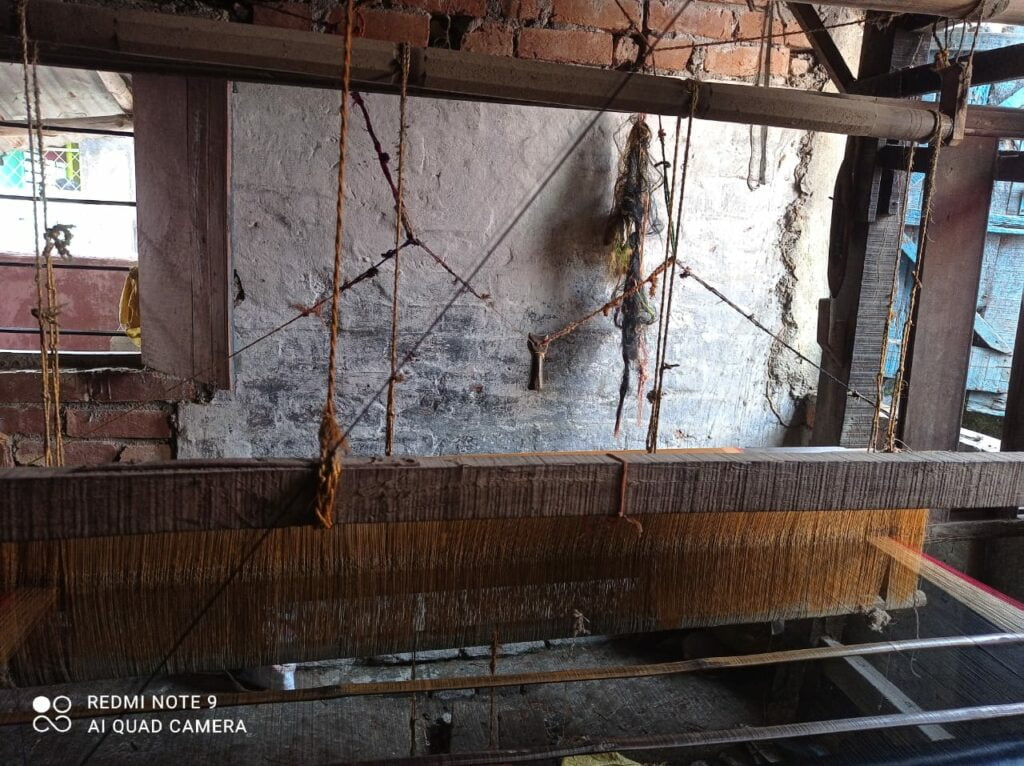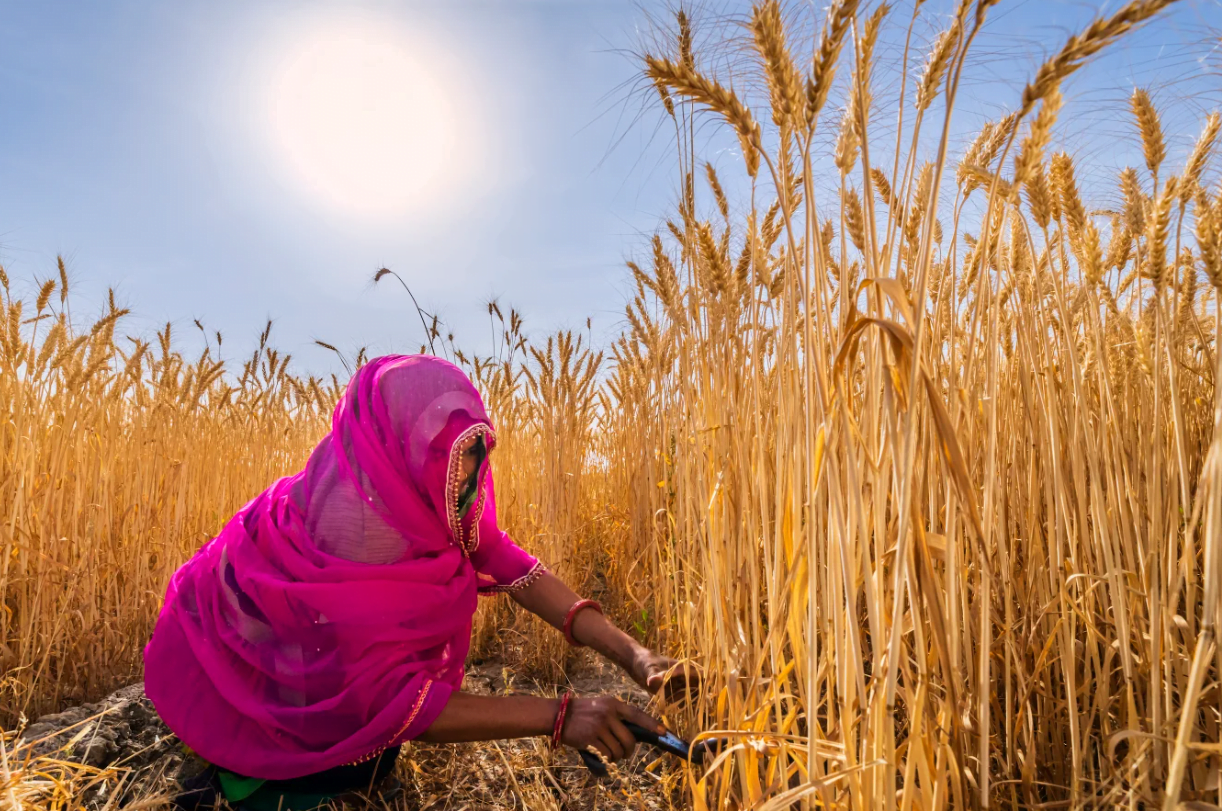In the Nadia district of West Bengal, Santipur and Phulia are regions famous for their handloom production. While the handloom saris are renowned for their comfort and intricate works and are sold at high prices in showrooms of Kolkata, the situation of the weavers is deteriorating day by day. The survey was conducted in the first half of December 2021 in Santipur, when the pandemic in West Bengal was moderately in control. I visited about eight households in the area for qualitative interviews.
The production process
Mahajans of the area majorly controls the entire production process. The weavers work on a contractual basis and are alienated from the final product. They mention, “We are not sure about at what price they sell the saris in the market and how the prices have changed during the pandemic; we just receive our wages.“

The production process has gone through a substantial change from using a hand-led loom to the usage of power looms. Looms are placed either in the front yard of one or two-room houses or occupy an entire room in the house itself, which is simultaneously used for other household activities (cooking, studying). Sagarika Nandi, who took a loan from Bandhan Bank in her name to buy power-loom for her husband, says, “During the lockdown with extremely low orders and the rising cost of electricity, it is becoming increasingly difficult for me to pay the loans.“
The production process has gone through a substantial change from using a hand-led loom to the usage of power-looms. Looms are placed either at the front yard of one or two-room houses or occupy an entire room in the house itself, which is simultaneously used for other household activities (cooking, studying). Sagarika Nandi, who took a loan from Bandhan Bank in her name to buy power-loom for her husband, says that “during the lockdown with extremely low orders and the rising cost of electricity, it is becoming increasingly difficult for me to pay the loans.”
Also read: Despite Poor Wages & Exploitation, Women Continue To Roll Beedi To Sustain Their Families
The primary reason behind the shift is that in the hand-led looms a maximum of one sari can be woven, while 4-5 can be weaved using the power loom in a day. The wages per sari range from INR 90-200 depending on the intricacy of the design. Weavers do not have orders for garments throughout the month. Pradip Bhowmik, who uses a hand-led loom, says, “I get a maximum of 16-17 orders in a month.” However, all the weavers recognise that there is a significant work-wage disparity. Sanat Ghosh, who owns a power-loom, says, “We do not have a union of workers, although we feel that the wage is unjust, we cannot do much about it, depending on Mahajans’ personal preference somebody gets paid more, someone, less.“
Designs of the saris keep on changing quickly to keep up with changing preferences of the market. Pradip Bhowmik says, “This is one of the major reasons I cannot set up a ‘poti’ (setting up a sari selling business like the Mahajans) even if I could manage for the capital somehow, I might just get stuck with unsold inventories.“
The changing structure of the business
Apart from the Mahajans, another category of businessmen has emerged for the last 7-8 years who buy saris both from Mahajans and the weavers to sell majorly on different online platforms such as Instagram or Facebook. At least 1000-1500 people are involved in this online business in the area. Such businessman, Sanjit Paul says that he has at least 3000 steady customers online. The younger, better-educated generations who do not want to become weavers but are unable to secure alternative employment are coming into this business. Sagarika Nandi laments, “We have heard about online business, but there is no internet connection in our houses, how can we sell there? The condition of the weaver community never changes.”
These businessmen also go to different handicrafts fairs such as “Poush Mela” in Santiniketan and “ Ghataler Mela” in Medinipur; however, the weavers can never afford to go there.

The women workers
In all the households, women are in some manner involved in the production process; however, most of them consider it as an extension of their domestic responsibility. Sagarika Nandi’s daughter says, “I prepare the yarn to help my father, along with my housework, as it’s a woman’s job.” Male weavers also view themselves as the sole income earners of the families; however, apart from yarn-making, women are involved in small tailoring works, which helps in sustenance.
Shibani Das, who operates the hand-led loom, considers herself a contributor to family income. Due to the shift from handloom to power loom, the women weavers of the area have suffered the most. As Sagarika Nandi says, “Women weavers in the area are scared to use such a big machine (the power loom), even when they taking loans to buy it, men of our houses can operate in better.“
State support and the pandemic situation
Although Santipur saris have a GQ tag, the government support for the weavers has been negligible. Only some of them received hand-led looms from the government but no help has been provided for the power looms. Pradip Bhowmik says, “I have received a handloom a few years back; however, it was full of wood-boring beetles (called ‘ghun poka’ in Bangla) and cannot be used. Instead, if they have given me the money I could have bought a better quality product.“
Weavers do not receive any support for visiting the state and national fairs. During COVID-19 with falling wage (maximum has reduced from INR 200 to 130 on an average) and a negligible number of orders, weavers had expected some special benefits or subsidies, but nothing has been provided to them apart from usual rations. All of them iterate similar sentiments, “Already the younger generations have moved outside the states in the hope of better income but they had to come back during Covid…. There are more mouths to feed now. Kids cannot attend online classes, and some of them work in local hotels or shops. We don’t know how to continue without government support. If we continue like this, the art will die in the next 50 years.“
Also read: Why Aren’t We Talking About Rural Women’s Mental Health?
As the online business flourished during this period, the Mahajans and the small businessmen of the area reap the benefits of it, and the urban customers can fulfill their desire of owning “classy-hand woven” saris from the comfort of their home; however, the plight of the weavers remains the same if not worse.
As the online business flourished during this period, the Mahajans and the small businessmen of the area reap the benefits it, and the urban customers can fulfil their desire of owning “classy-hand woven” saris from the comfort of their homes; however, the plight of the weavers remains the same if not worse.
As one of them says, “The babus of the city involved in big business and office jobs, will never consider us human beings….this will never change.“
Srimanjori Guha is a PhD scholar at the Centre for Development Studies, Kerala. She is interested in gender economics. You can find her on Facebook.
The author would like to thank Trisha Adhikary and the weavers’ community in Santipur for their support.
All images as provided by the author.




